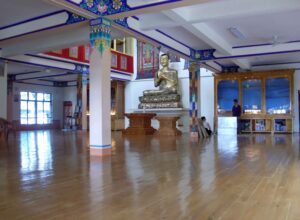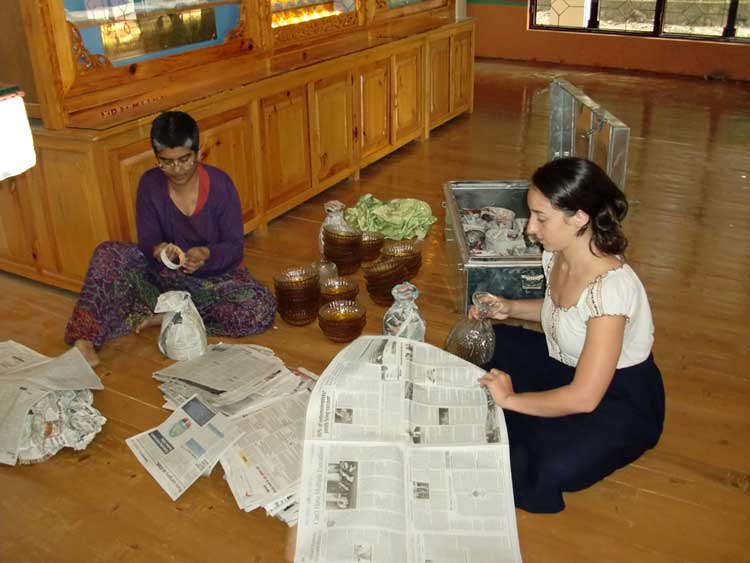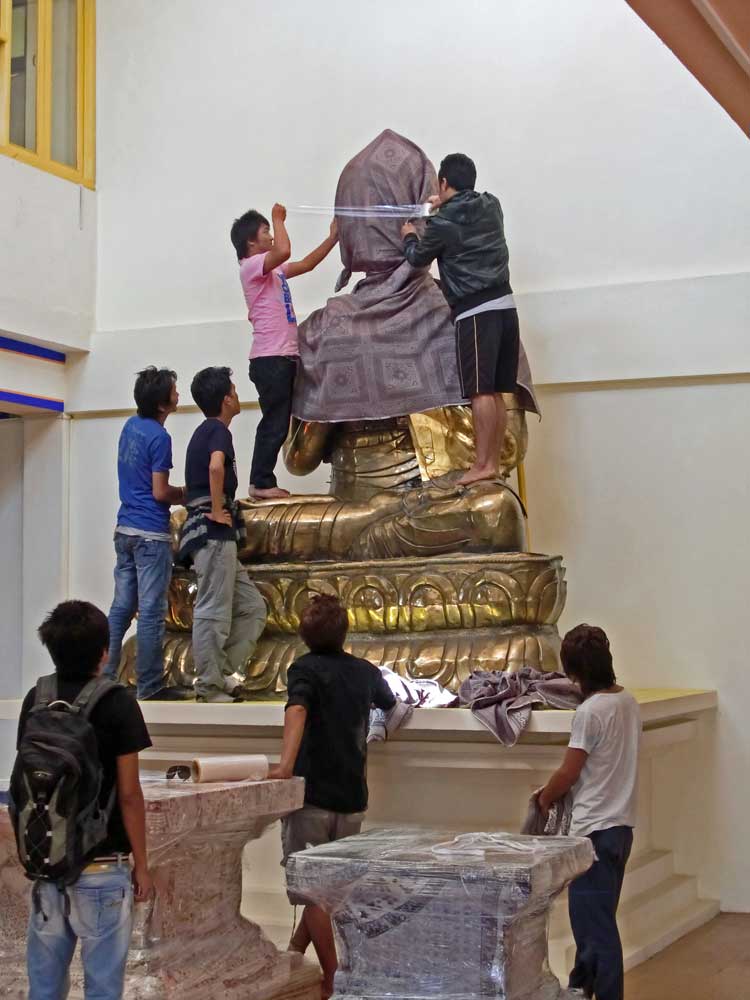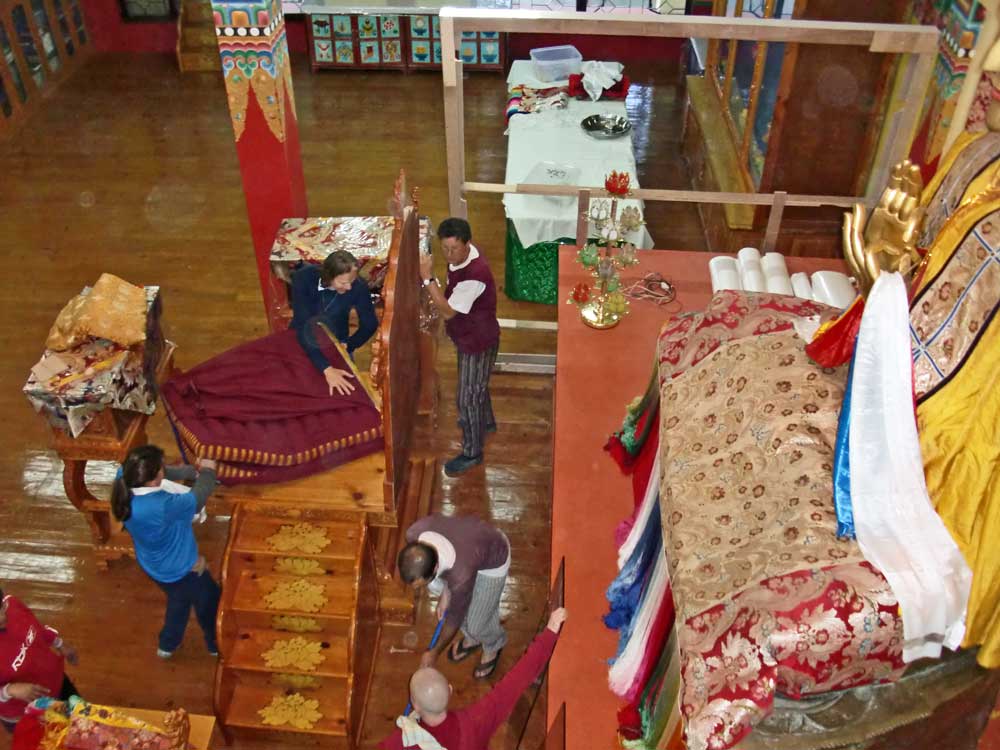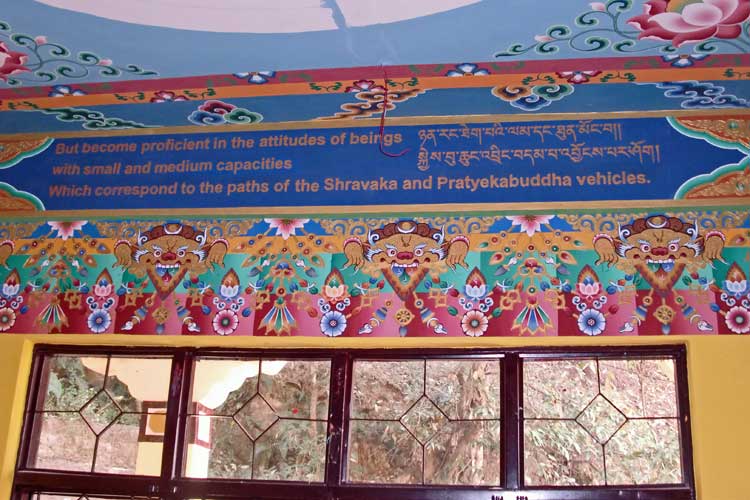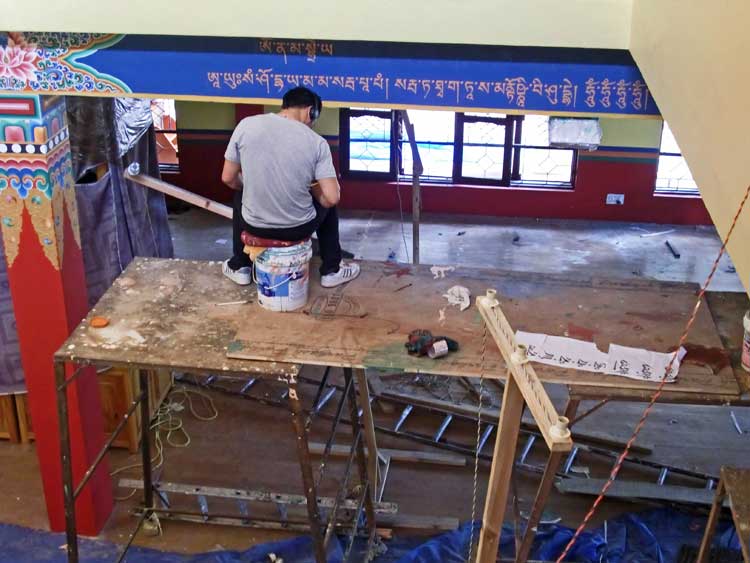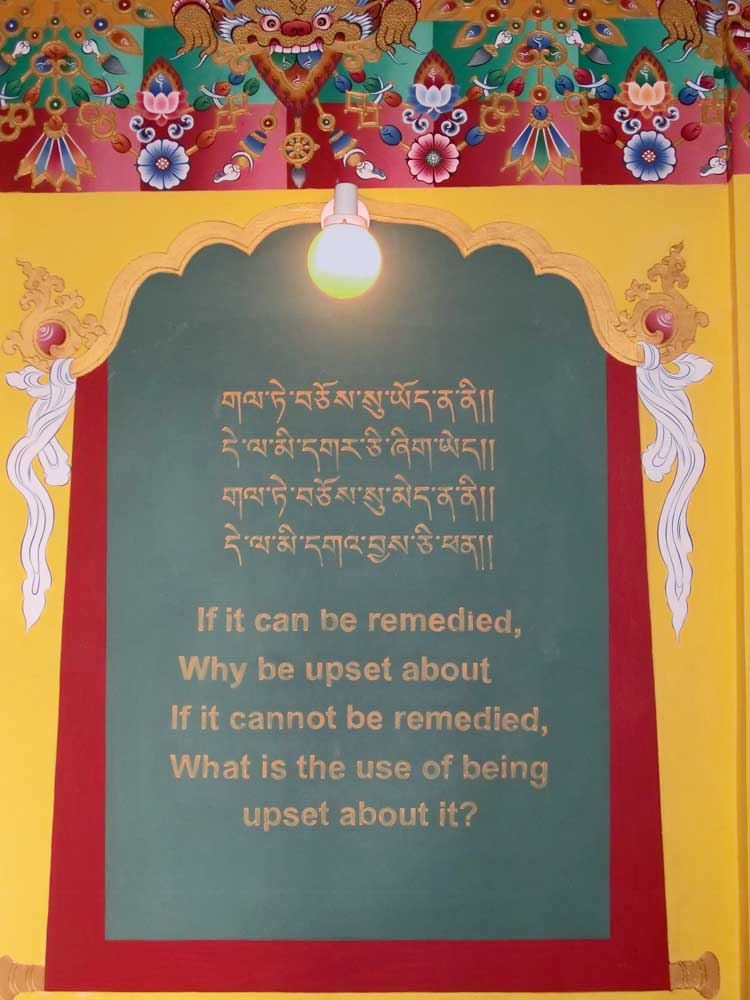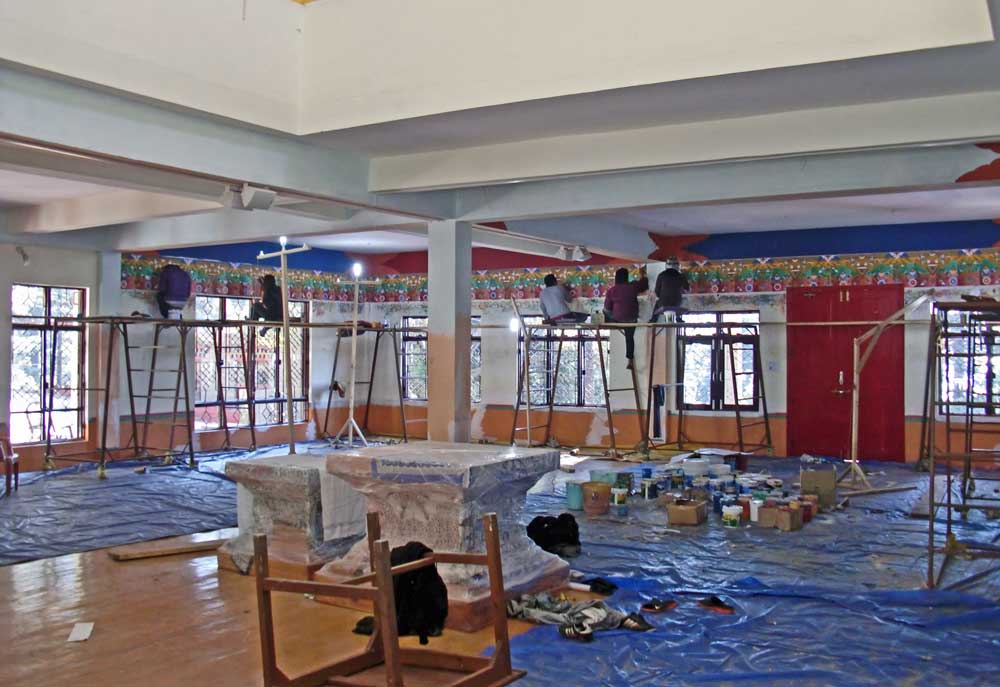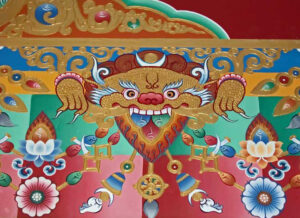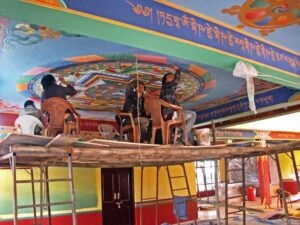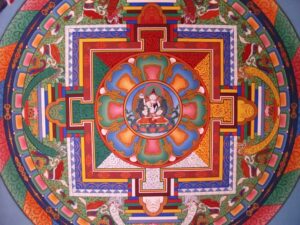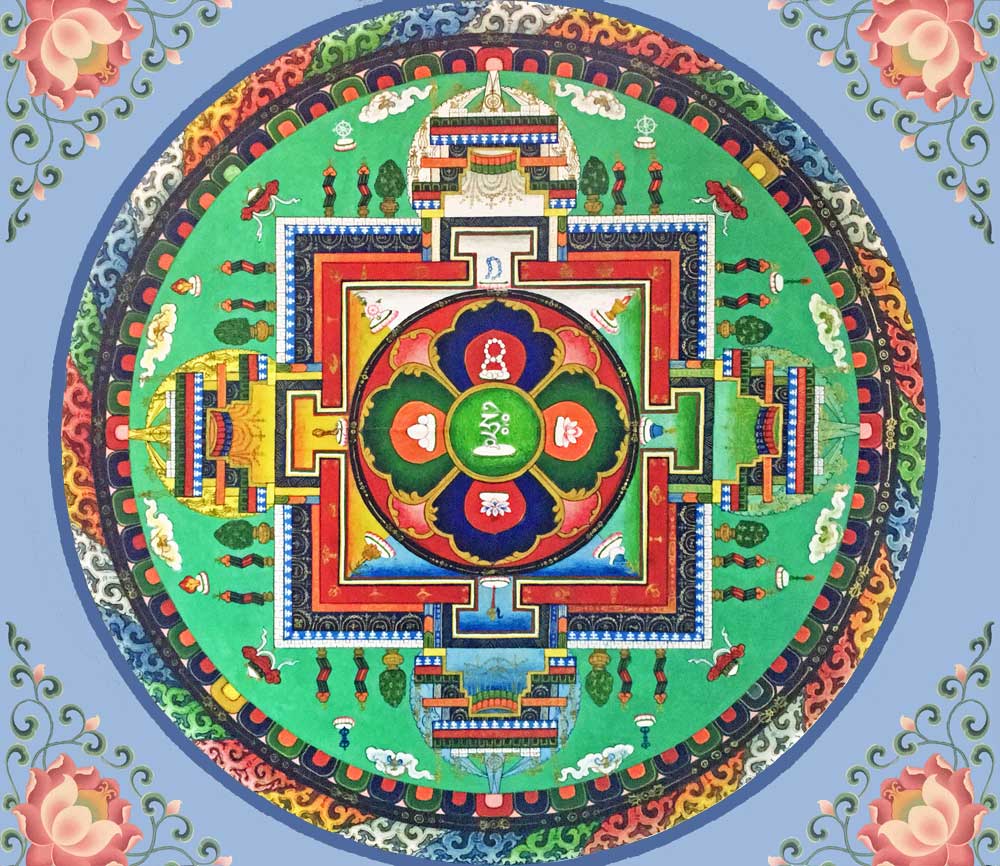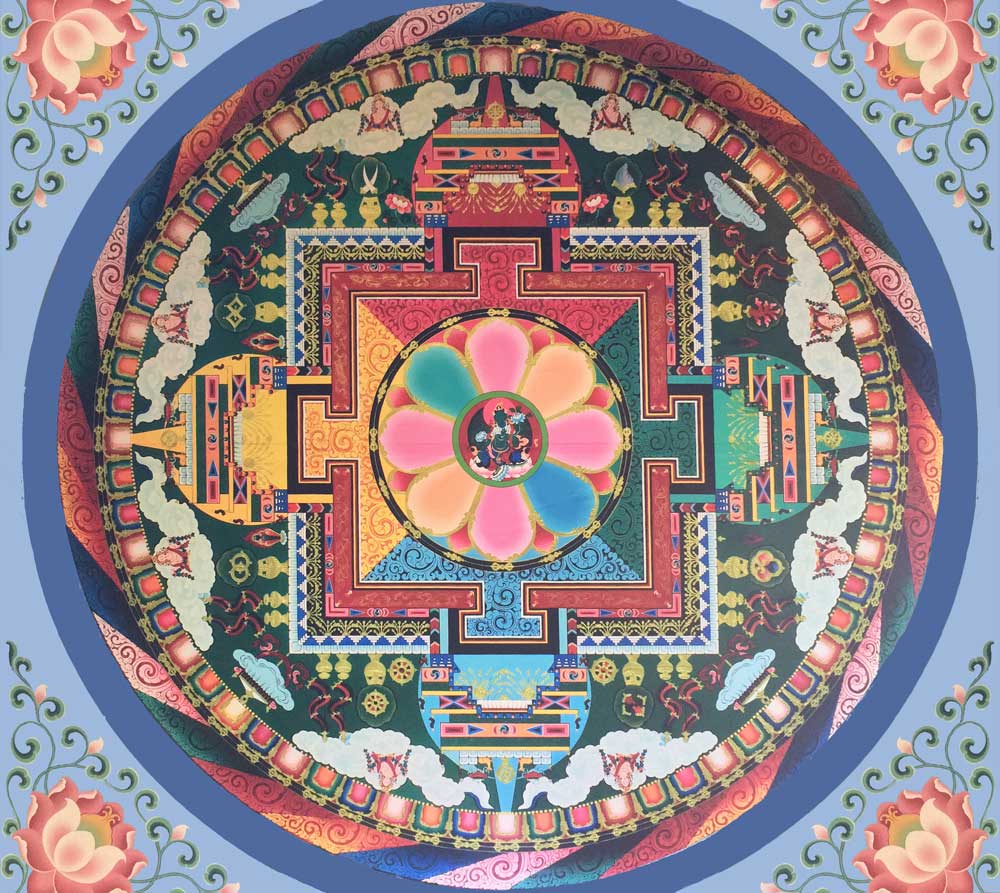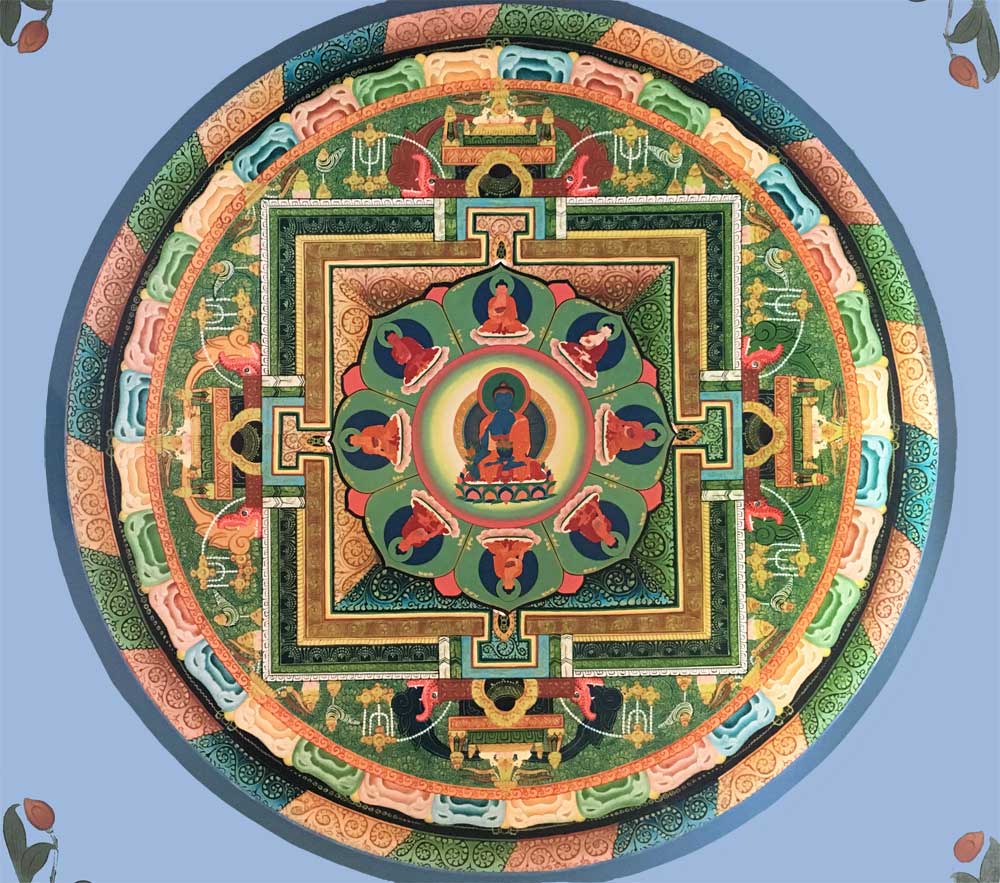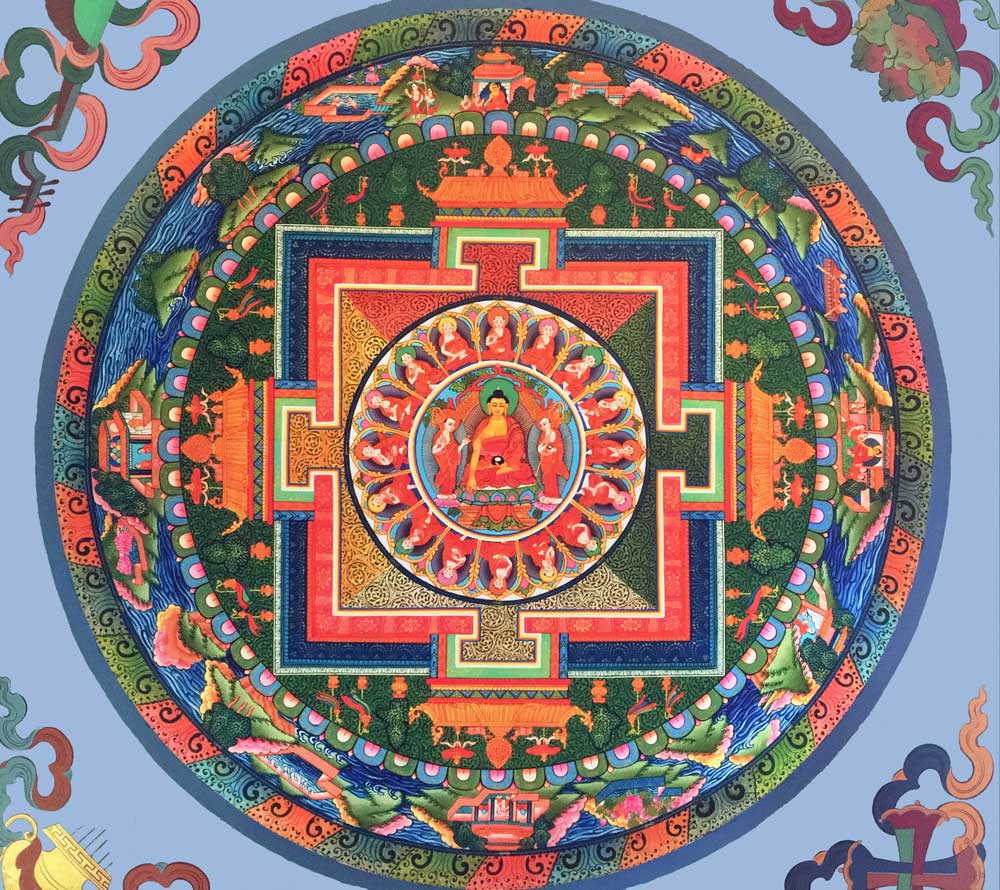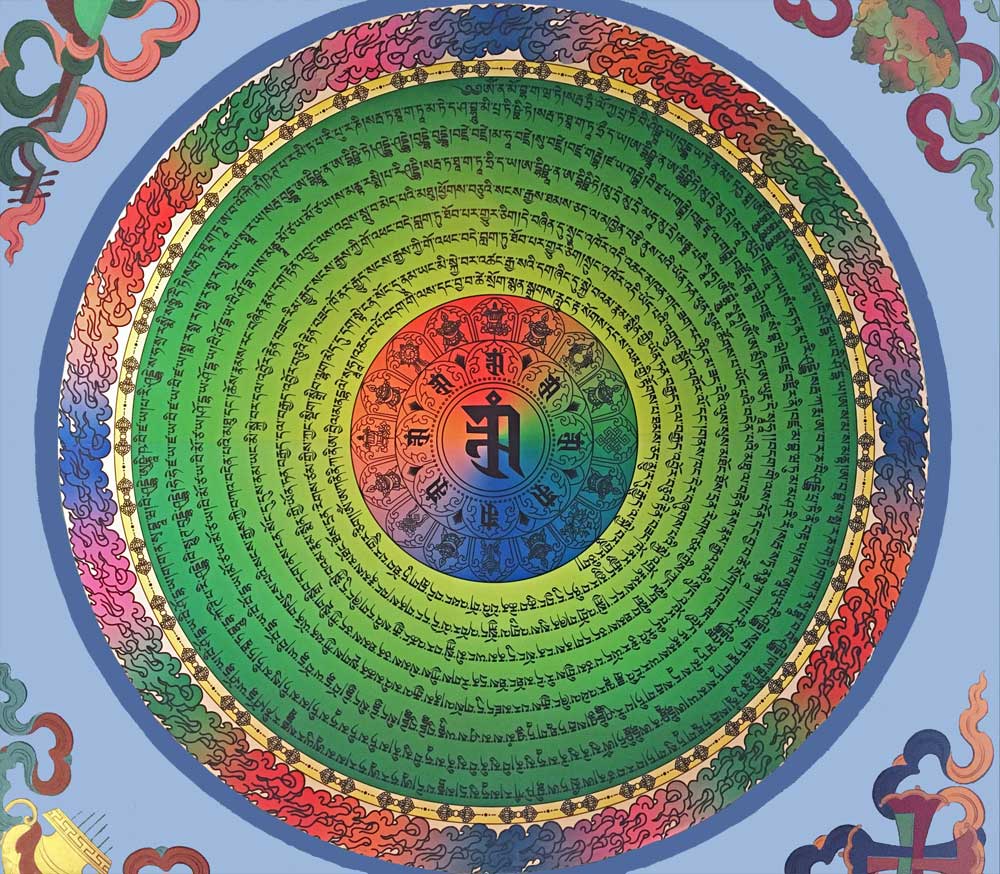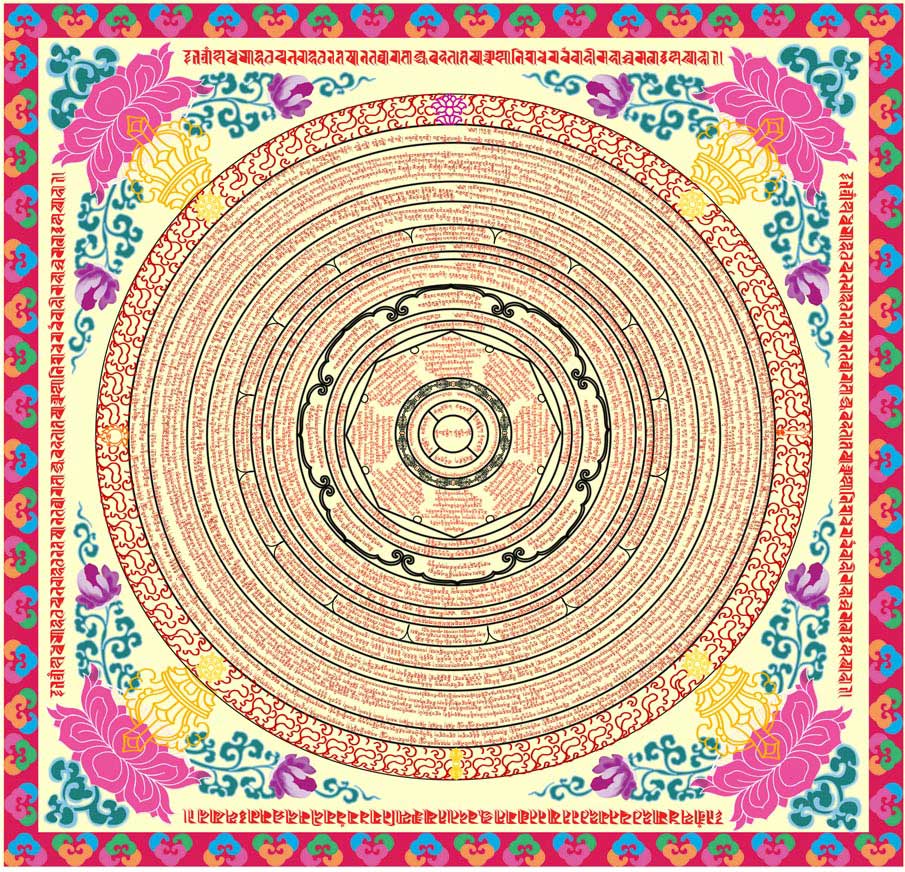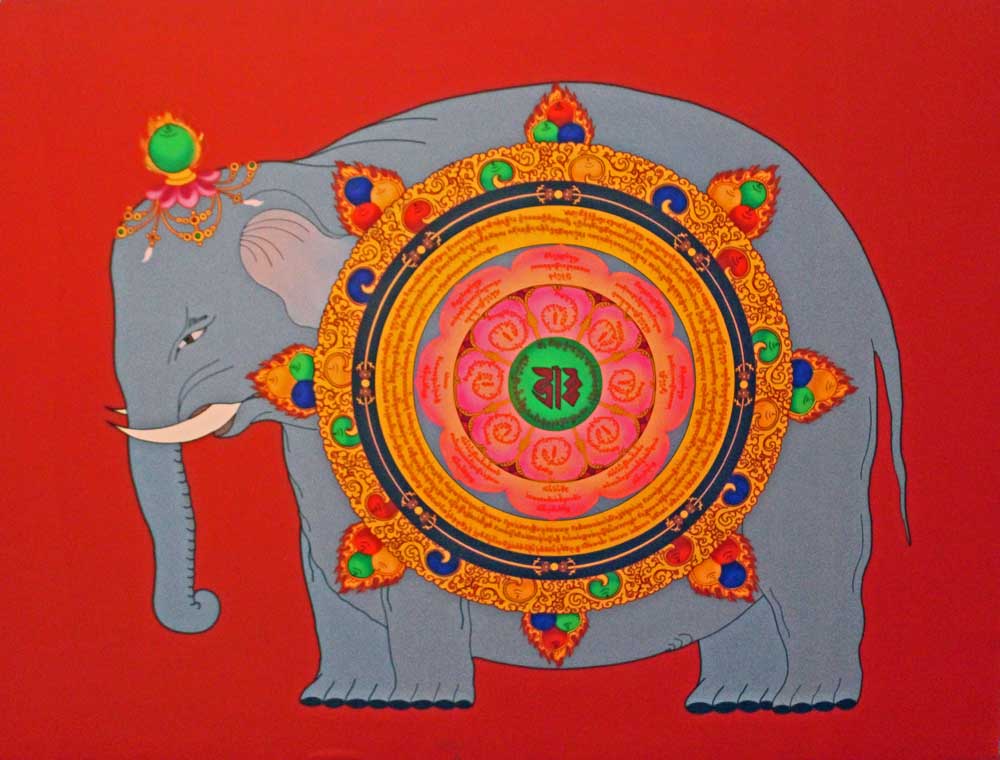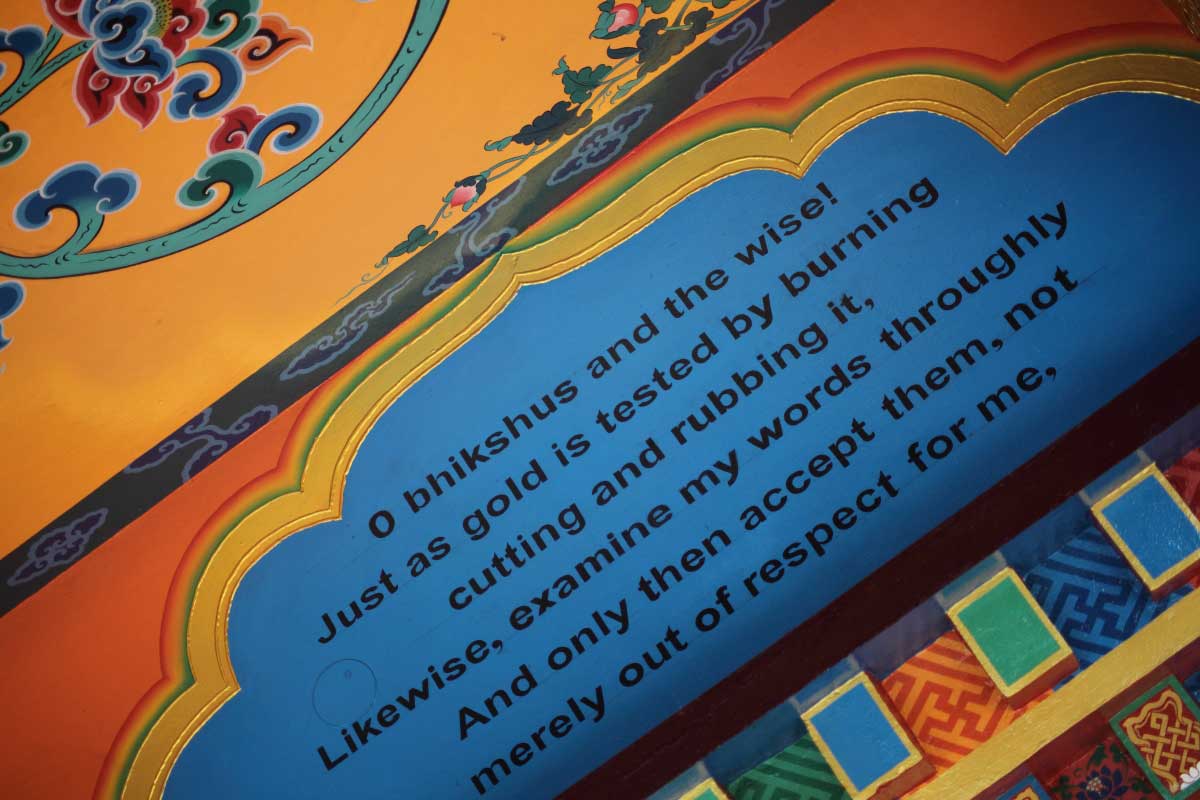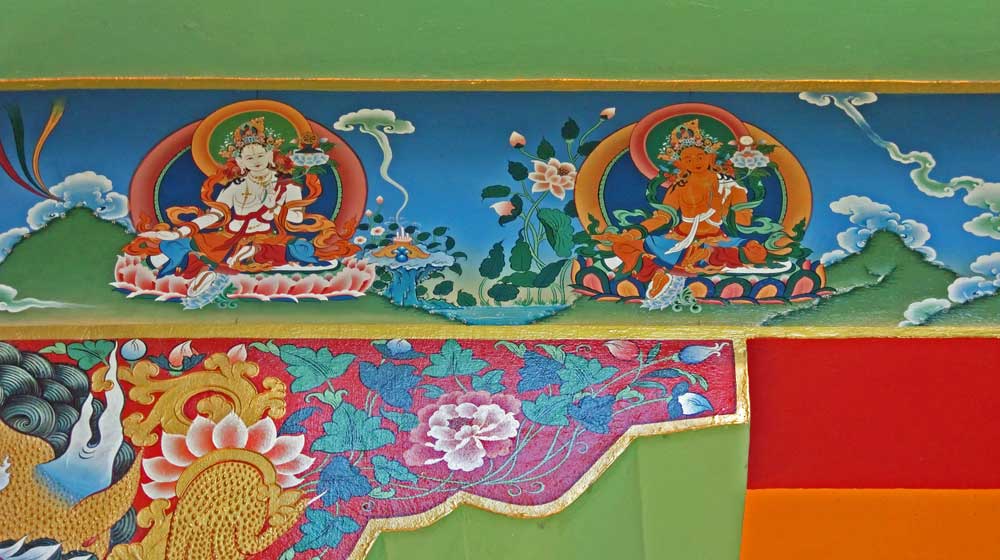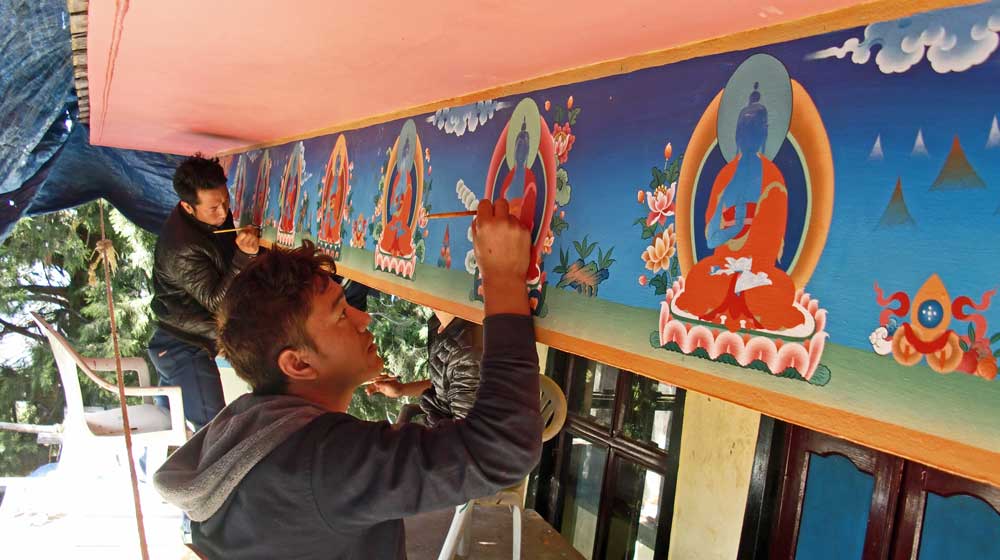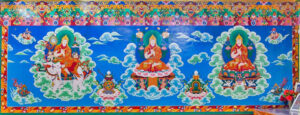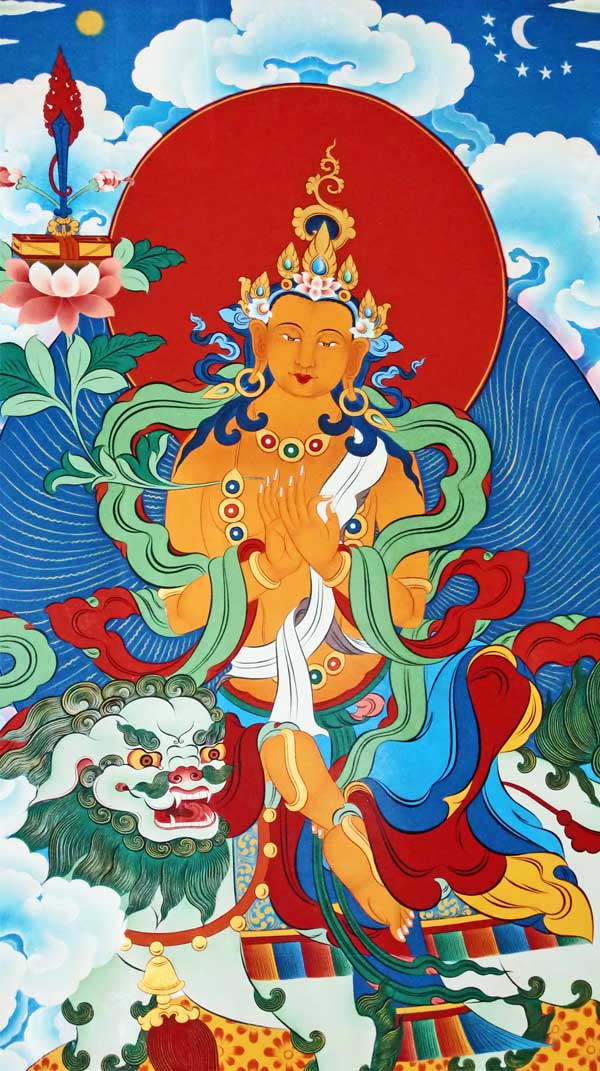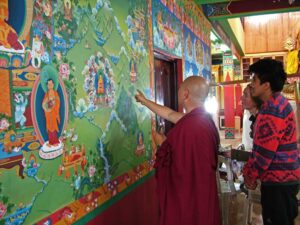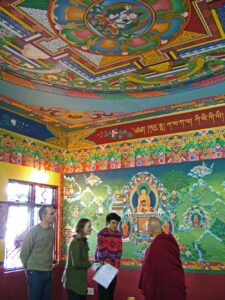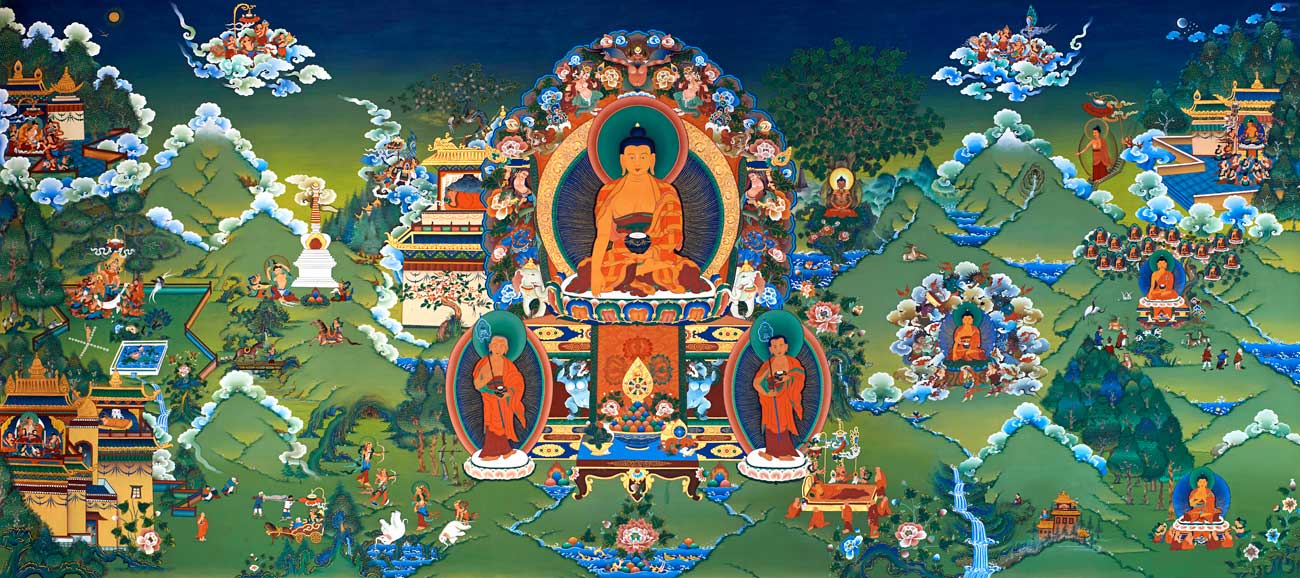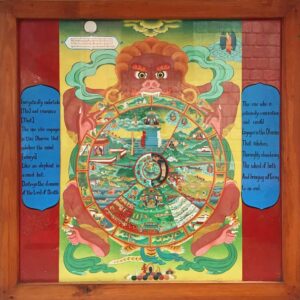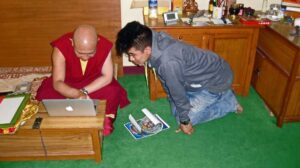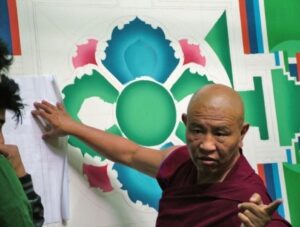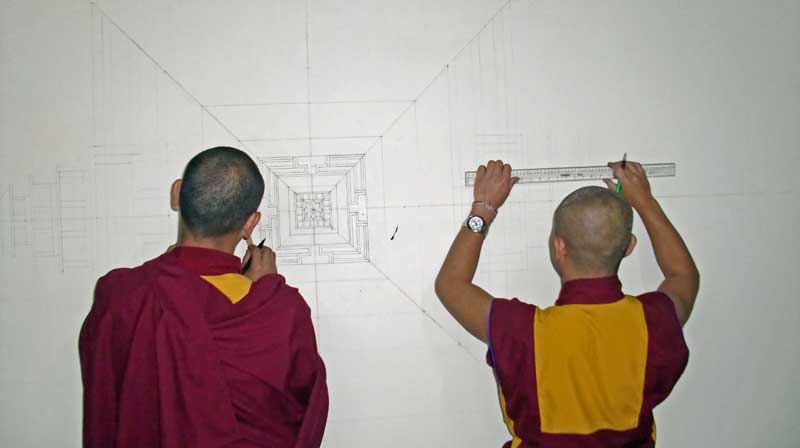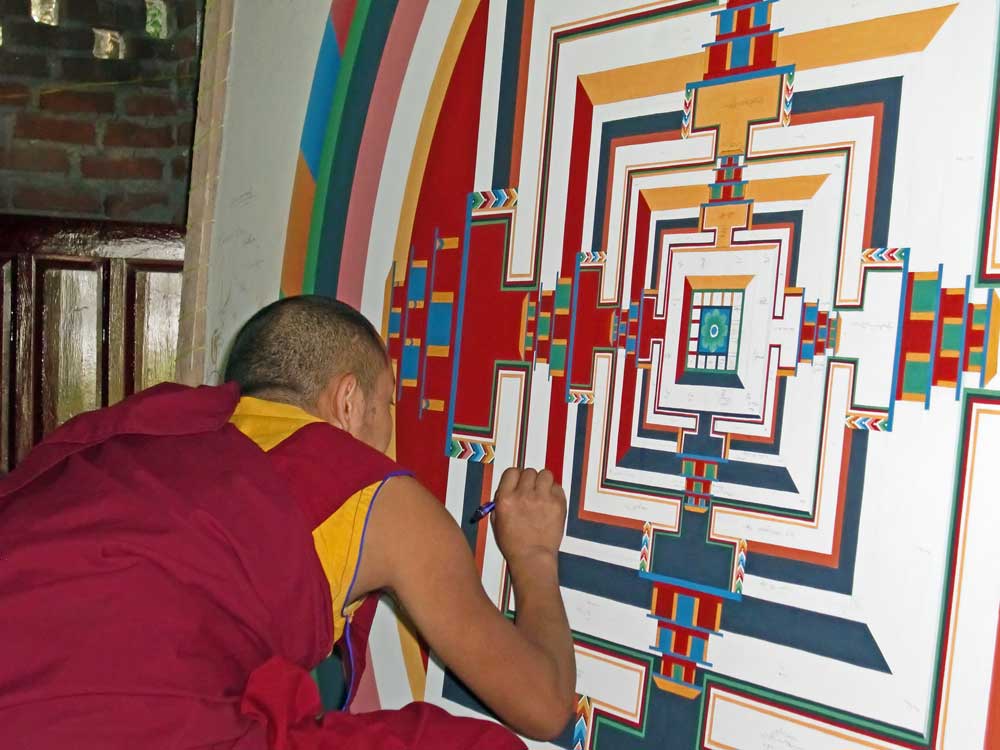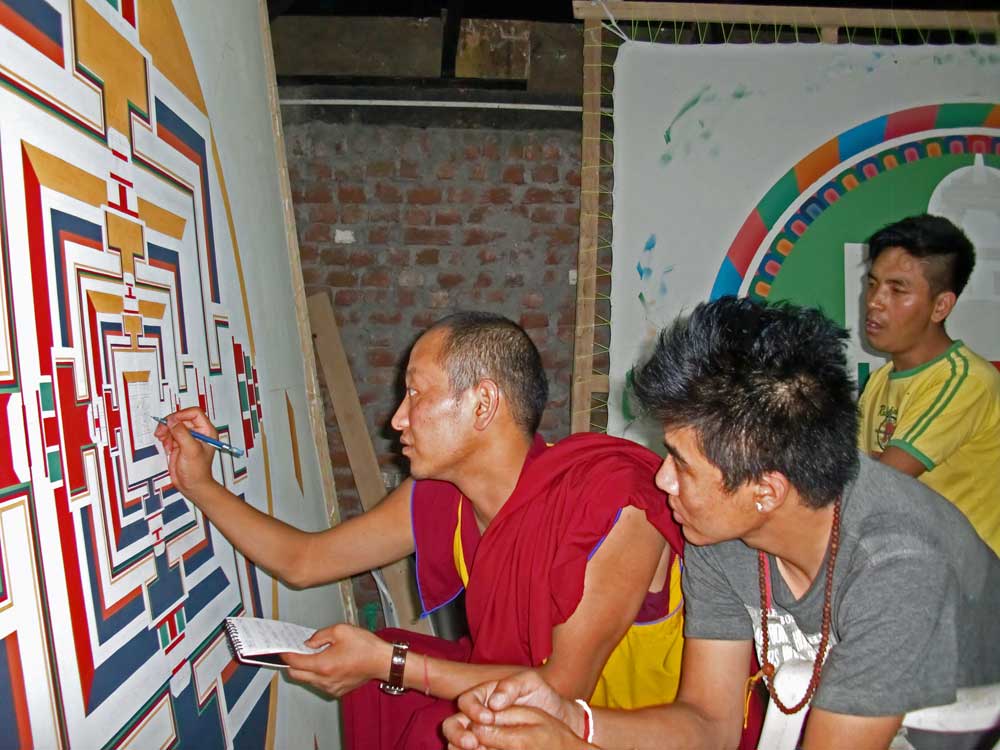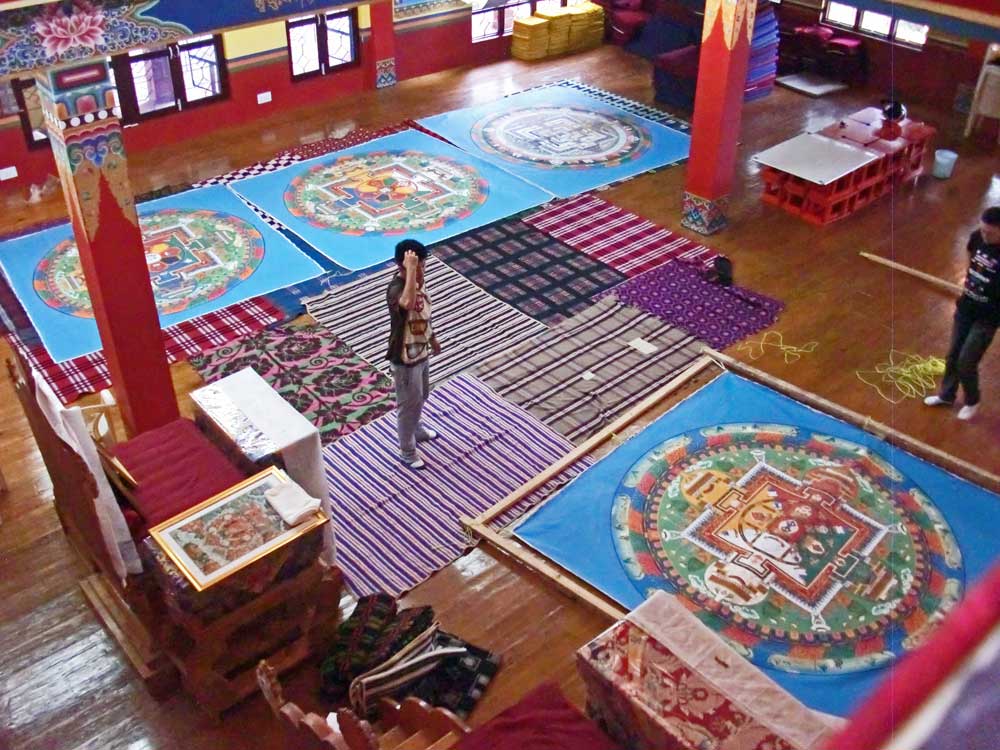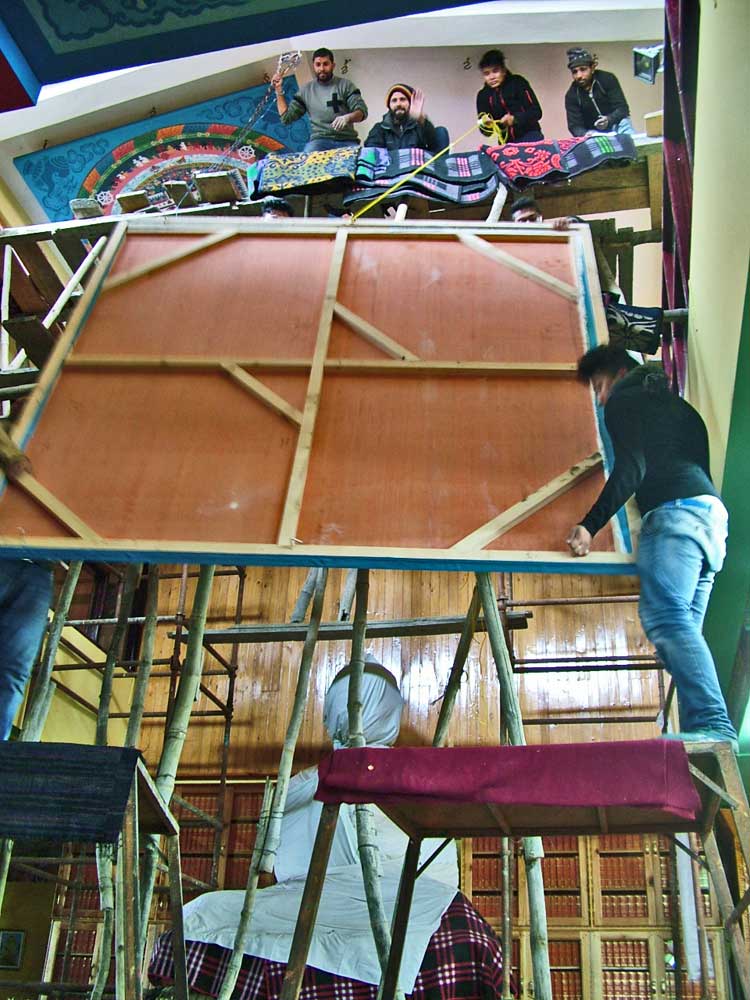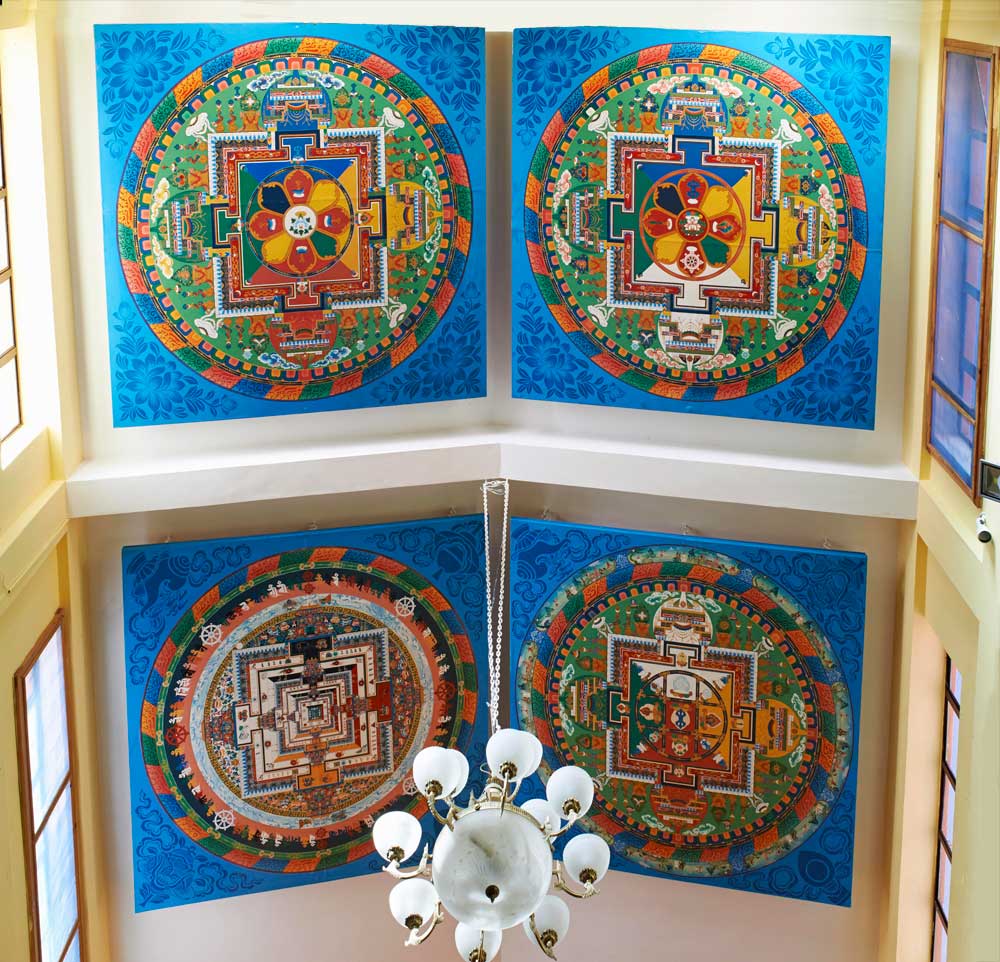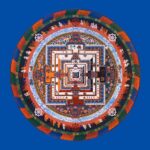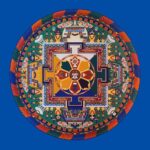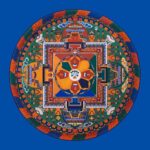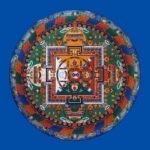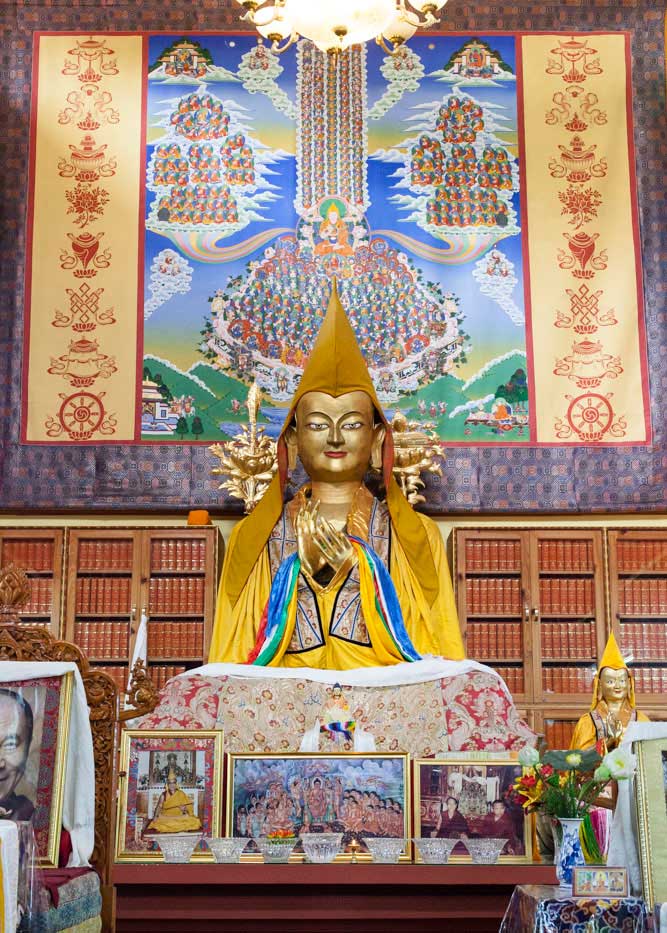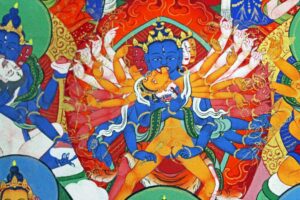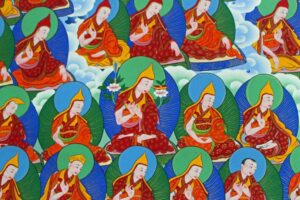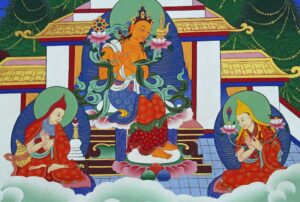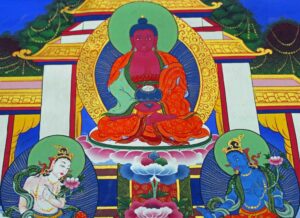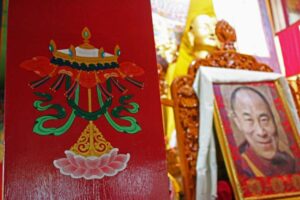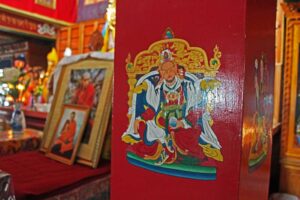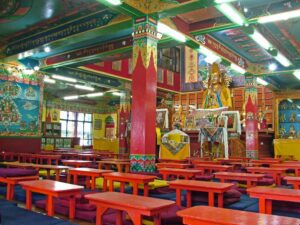GOMPA PAINTING PROJECT
Since Tushita’s Main Gompa (meditation hall) first opened its doors in March 2008, we have been very blessed by several visits from our founder and spiritual director Kyabje Lama Zopa Rinpoche.
Rinpoche has provided extensive advice for the development of Tushita’s Main Gompa including its paintings both inside & out. Rinpoche’s advice has been based on consultation with Jhado Rinpoche & Khadro-la (Rangjung Neljorma Khadro Namsel Drolma). We have been extremely fortunate to have such guidance and such a rich painting vision.
You can see the short film we made of this initial process on our Video resources page, or on our Vimeo account
History of the Gompa Painting Project.
It took several years to acquire all the necessary resources and advice until finally in July 2012 we held a series of key planning meetings with our painting team. We explored in detail Lama Zopa Rinpoche’s extensive advice and how to best fulfill that within the limits of the space available.
Rinpoche emphasized the importance of making the space as meaningful as possible. For example, in the case of the background features instead of flowers and beautiful ornamentation we painted images such as the Thirty-five Buddhas, the Twenty-one Taras, and mantras as a means for students to create even more merit.
We began by visiting the painters at their then-current project sites in the village of Bir. In this way we were better able to understand how the painters work and the preparations and equipment needed.
It felt at times like a giant jigsaw with more and more pieces falling into place.
PHASE 1
The first phase lasted eight months from September 2012 until April 2013. The Gompa was closed and Tushita’s housekeeping team began the tremendous job of carefully packing and storing everything within. Eight painters arrived and commenced their preparations for the great transformation of our Main Gompa.
Lama Zopa Rinpoche instructed us to paint verses emphasizing bodhicitta as well as death and impermanence. Eighteen verses were selected to be painted on the ceiling beams and the walls in both Tibetan and English. These were selected from texts including Shantideva’s The Bodhisattva’s Way of Life, the Lama Chӧpa Guru Puja text, the sutras, and writings from the seventh Dalai Lama.
The painters spent the first two months patiently preparing the background of the walls and beams. The beams were prepared for mantras and verses with beautiful flower adornments. A very detailed and stunning shambu design (a silky, ruffled banner hung from the ceiling representing descending blessings) was painted around the top section of all the walls. Once the shambu was complete the painters turned their attention toward the design for the Vajrasattva mandala, working from an image provided from Lama Zopa Rinpoche’s collection.
The Vajrasattva mandala took three months of very careful work to complete. This mandala was painted just inside of the main doors in the largest ceiling section of the Gompa. As the work progressed more and more painters worked together to complete the fine details of the mandala. It was an amazing sight to behold as they worked together so closely and carefully.
Although we originally planned to have most of the lower ceiling mandalas painted we later received advice to print them instead. Thus the Vajrasattva mandala is the only one that is painted on the lower ceiling level. The printed mandalas are as follows: Thousand-Armed Chenrezig, Tara, Medicine Buddha, the Sixteen Arhats, and Namgyalma. Additionally, we installed two chakra images: Dhonyo, and the Wheel of the Meritorious Elephant Generating Power.
Pictured above: 1000-arms Chenrezig, Tara, Medicine Buddha, 16 Arhats, Namgyalma, Dukkar (Sitatapatra), and Wheel of Meritorious Elephant Generating Power.
Finally, five powerful mantras were painted on the main beams around the Lama Tsongkhapa statue. These five mantras are those of Mitrugpa, Stainless Pinnacle, Kunrig, Wish-Granting Wheel, and Namgyalma. They assist in freeing sentient beings from the lower realms.
PHASE 2
The next phase shifted to the Gompa’s exterior, making use of the spring months from April to June 2013. Here you can see the beautiful paintings of the Twenty-one Taras, and the Eight Medicine Buddhas. Additionally, you can find several verses from classic Tibetan texts as well as the following verse that is attributed to Shakyamuni Buddha and located by the main Gompa doors:
Oh Bhikshus and the wise! Just as gold is tested,
Through burning, cutting, rubbing,
Likewise, examine my words thoroughly,
And only then accept them, not merely out of respect for me
PHASE 3
From July 2013 to June 2014 the following six paintings were completed:
The mural of Four Lama Tsongkhapa Aspects. Inside the Main Gompa you will find three of the Lama Tsongkhapa aspects on one of the walls of Lama Yeshe’s room. The fourth is located next to the teacher’s entrance. Each were painted with tremendsou love, patience, and care which is clearly reflected in their craftsmanship.
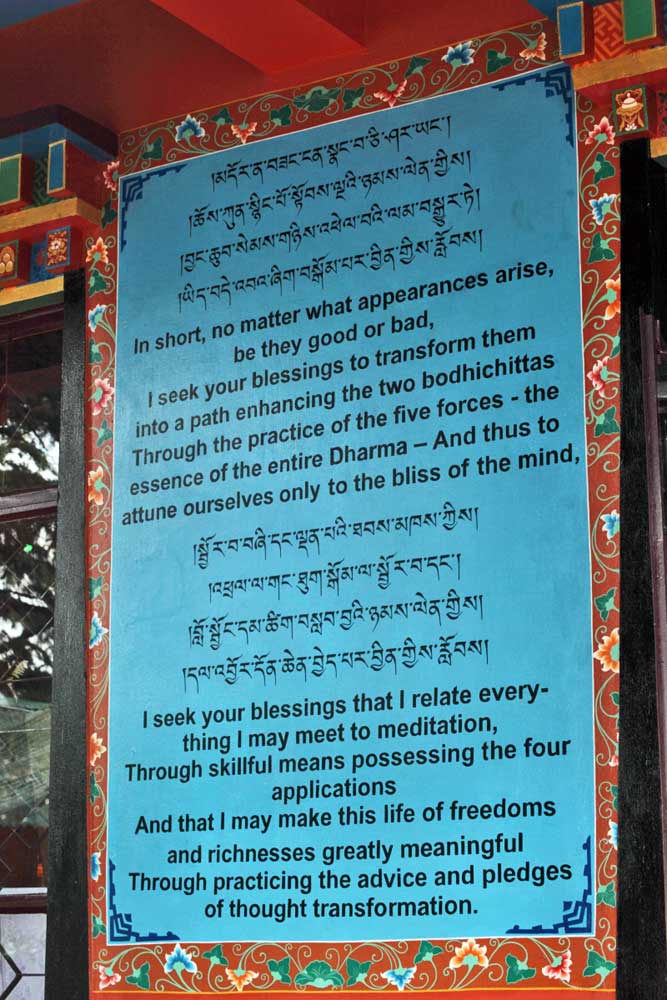 Four sets of mantra window blocks. This work has helped to truly transform the outside appearance of the Gompa.
Four sets of mantra window blocks. This work has helped to truly transform the outside appearance of the Gompa.
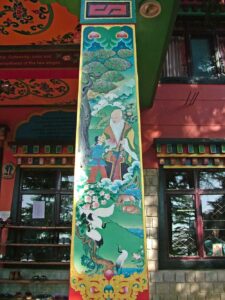
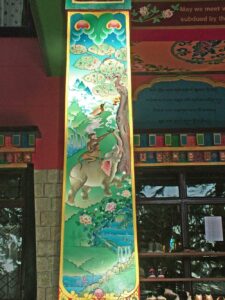 The Six Long-Life Symbols, and the Four Harmonious Friends. These adorn the main pillars as you enter the Gompa.
The Six Long-Life Symbols, and the Four Harmonious Friends. These adorn the main pillars as you enter the Gompa.
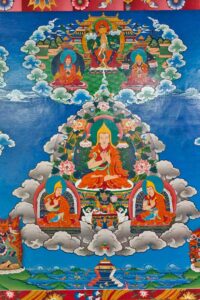 The Lama Tsongkhapa Guru Yoga mural. This is one of the main pieces the painters worked on throughout the winter months.
The Lama Tsongkhapa Guru Yoga mural. This is one of the main pieces the painters worked on throughout the winter months.
The Twelve Deeds of the Buddha mural. This is definitely a masterpiece of the Gompa Painting Project! Jhado Rinpoche was extremely generous with his time and vast knowledge during the course of this painting. He monitored the progress and offered guidance to ensure the accuracy and quality of every little detail of this complex mural. We remain deeply grateful for his assistance!
At the time of its painting, one of the painter’s parents passed away in Tibet. In remembrance of the deceased parent and as a gesture of generosity real gold paint was applied to certain parts of the artwork. This provides an additional depth of radiance to the piece.
The Wheel of Life. This traditional image illustrates the Buddhist teachings on samsara or “cyclic existence” and the path of liberation. The detailed symbolism can be interpreted on many levels.
In contrast to many of the paintings which were applied directly to the gompa walls, this was painted on canvas and now hangs on the small utility building at the southwest corner of the Main Gompa. Jhado Rinpoche very kindly supervised this project and put special emphasis on the meaning of the verses included that describe the path to enlightenment. Lama Zopa Rinpoche has translated the verses into English on the sides. At pertinent times we print out and distribute to students copies of this image along with the teachings given by Rinpoche explaining its meaning.
PHASE 4.
The final phase of the Gompa Painting Project spanned from July 2014 to May 2015. Two main projects were at the core of this phase: the four Highest Yoga Tantra mandalas and our massive Lama Chӧpa Merit Field thangka.
Four Highest Yoga Tantra mandalas. These mandalas (Chenrezig, Gyalwa Gyatso, Kalachakra, and Yamantaka) were painted on canvas in our fire puja house and then installed inside the Gompa on the high ceiling above Lama Tsongkhapa’s statue.
Once again Jhado Rinpoche was central to this process. Not only did Rinpoche monitor and advise the painters several times, he also drew the structure of three of the mandalas himself. After reviewing the final result Rinpoche said that these mandalas should serve as a reference for anyone doing retreat or using them in their practice.
The Kalachakra mandala is especially complex. For this we requested the help of Namgyal Monastery (His Holiness Dalai Lama’s Temple in McLeod Ganj) who sent two expert monks to draw the mandala.
Once the mandalas were completed and approved by Jhado Rinpoche, they were framed and hauled up to the highest ceiling of the Main Gompa via a seven-meter-high wooden scaffolding crafted just for this purpose. The installation was complete in January 2015.
We have wonderful photos of the mandalas taken by our friend Tim Roodenrys:
From Left to Right: Kalachakra, Gyalwa Gyatso, Chenrezig, Yamantaka.
The Lama Chӧpa Merit Field Thangka. Another masterpiece envisioned by Lama Zopa Rinpoche! This stunning thangka hangs behind our Lama Tsongkhapa statue on the main altar.
A thangka is a Tibetan Buddhist painting on fabric which usually depicts a deity, scene, or mandala, and is hung surrounded by a brocade frame. They are appreciated not only as beautiful pieces of art but more importantly as a means to assist meditational practices.
The Lama Chӧpa Merit Field is the visualization before which we practice going for refuge, making offerings, prostrations, prayers, and requests for special purposes in order to accumulate merit and wisdom.
Our immense thangka spans 15 ft x 12.7 ft (4.6 x 3.8 meters). It is composed of 409 individual deities and was custom made using the finest materials and pure gold paint. A team of 5 painters worked full time for over 9 months to complete the painting while overcoming many obstacles beginning with finding a nearby room high enough to fit the canvas. During the overwhelming moisture of the monsoon they had to use heaters and dehumidifiers to keep the canvas dry enough for the artists to paint on it.
His Holiness the Dalai Lama’s tailor arranged the silk brocade that frames the canvas upon completion. The result is breathtaking! Here some details of the painting to admire.
Details of the thankga:
Finishing Touches. After all this was complete there were just two unadorned spots in the Gompa! Lama Zopa Rinpoche advised we resolve this by adding the Seven Royal Possessions [1] and the Eight Auspicious Signs [2]. And thus the ambitious Gompa Painting Project was achieved!
Pictured above: Precious Umbrella & Precious Minister.
Such a massive transformation to the Main Gompa has been extraordinary to witness. Realizing Rinpoche’s vast vision for Tushita proved to be a multi-layered project of piecing together the various elements that gradually manifested as the magnificent whole seen today. We pray that innumerable students and visitors will find tremendous benefit from these paintings for many years to come!
A Big Thank You from Tushita to all the Kind Beings who made this Possible!
Special thanks to Grace Gyatso (previous Linda) who was involved in this project from the very beginning. She devoted so much time and effort to it while working as Tushita Meditation Centre’s Director until March 2014.


